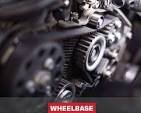drwebb
Automotive
- Oct 23, 2002
- 406
So Honda is having trouble with their V6 main bearings: https://www.cnn.com/2024/11/11/business/honda-engine-recall/index.html
Not a good look such a basic component has a defect coming from an OEM that leans into their engine durability prowess (or at least used to).
Not a good look such a basic component has a defect coming from an OEM that leans into their engine durability prowess (or at least used to).
Last edited:



